Managerial Accounting Assignment: Cost and Performance Analysis
VerifiedAdded on 2021/05/31
|30
|3829
|187
Homework Assignment
AI Summary
This managerial accounting assignment solution provides a detailed analysis of various cost and performance-related topics. It covers variance analysis, including variable and fixed overhead variances, direct material and labor variances, and their economic significance. The solution also delves into sales compensation strategies, evaluating different approaches from both employee and employer perspectives. Furthermore, the assignment explores return on investment (ROI) and economic value added (EVA) calculations to assess the performance of different business divisions, offering recommendations based on the financial results. The document includes figures and calculations to support the analysis, providing a comprehensive understanding of the managerial accounting concepts discussed.
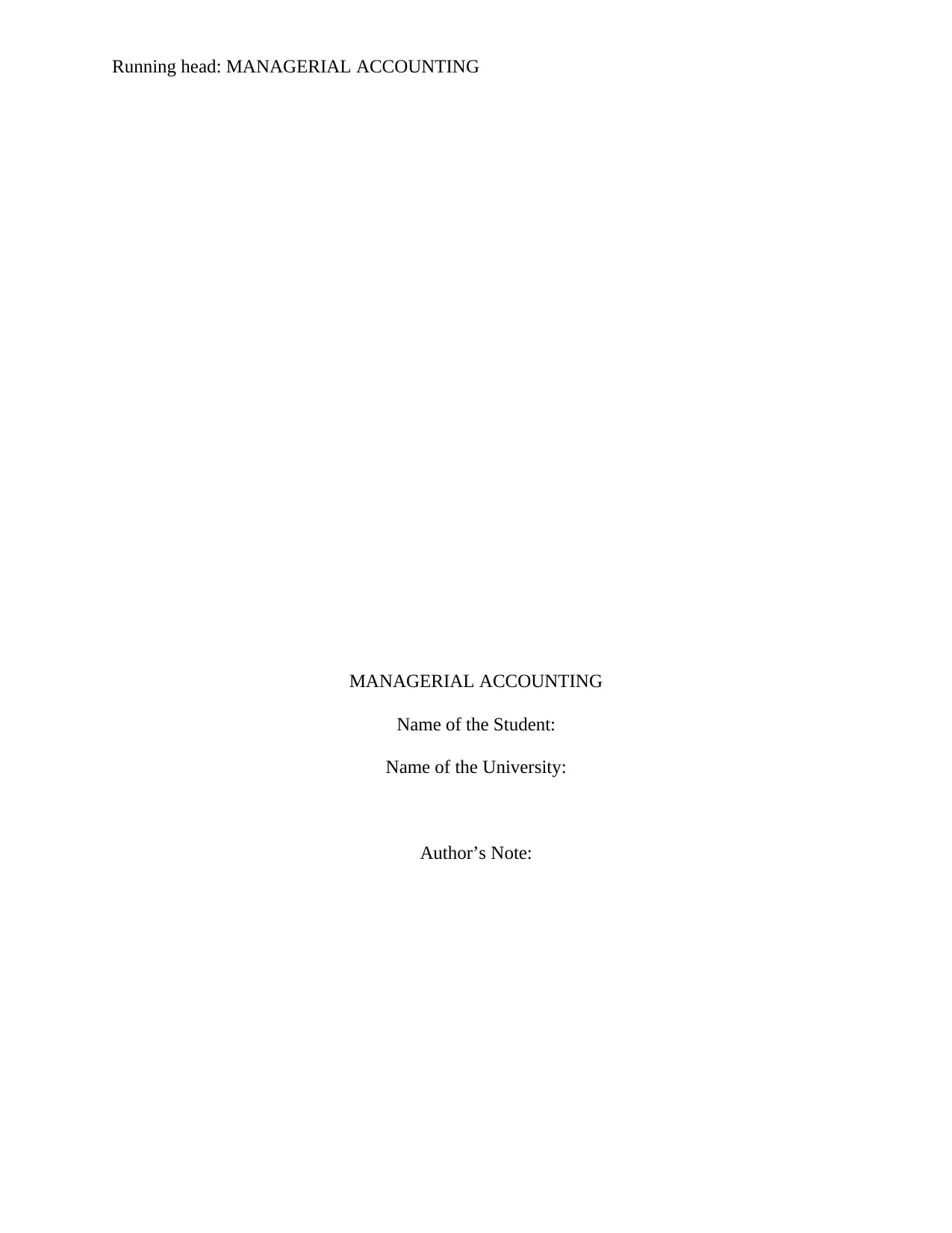
Running head: MANAGERIAL ACCOUNTING
MANAGERIAL ACCOUNTING
Name of the Student:
Name of the University:
Author’s Note:
MANAGERIAL ACCOUNTING
Name of the Student:
Name of the University:
Author’s Note:
Paraphrase This Document
Need a fresh take? Get an instant paraphrase of this document with our AI Paraphraser
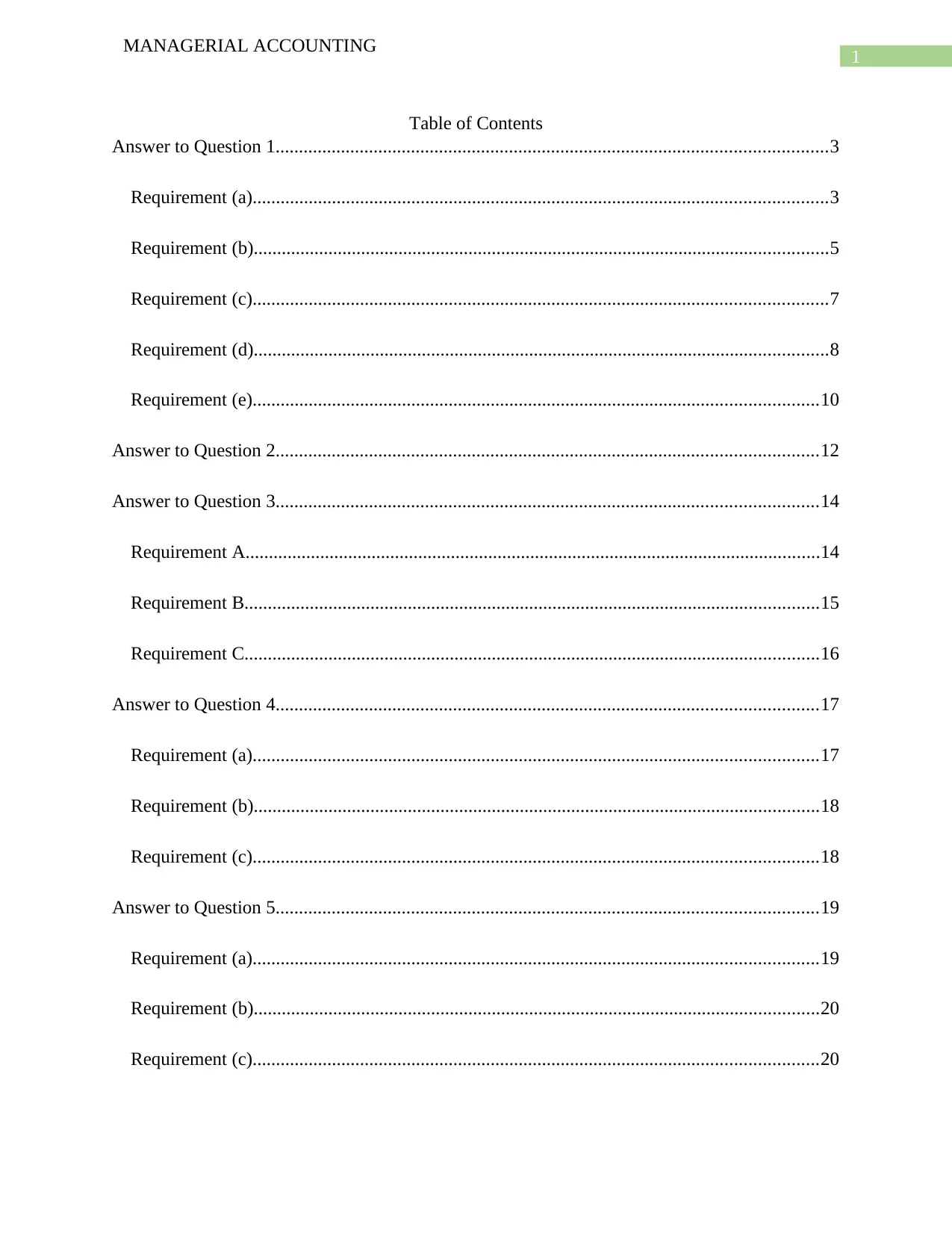
1
MANAGERIAL ACCOUNTING
Table of Contents
Answer to Question 1......................................................................................................................3
Requirement (a)...........................................................................................................................3
Requirement (b)...........................................................................................................................5
Requirement (c)...........................................................................................................................7
Requirement (d)...........................................................................................................................8
Requirement (e).........................................................................................................................10
Answer to Question 2....................................................................................................................12
Answer to Question 3....................................................................................................................14
Requirement A...........................................................................................................................14
Requirement B...........................................................................................................................15
Requirement C...........................................................................................................................16
Answer to Question 4....................................................................................................................17
Requirement (a).........................................................................................................................17
Requirement (b).........................................................................................................................18
Requirement (c).........................................................................................................................18
Answer to Question 5....................................................................................................................19
Requirement (a).........................................................................................................................19
Requirement (b).........................................................................................................................20
Requirement (c).........................................................................................................................20
MANAGERIAL ACCOUNTING
Table of Contents
Answer to Question 1......................................................................................................................3
Requirement (a)...........................................................................................................................3
Requirement (b)...........................................................................................................................5
Requirement (c)...........................................................................................................................7
Requirement (d)...........................................................................................................................8
Requirement (e).........................................................................................................................10
Answer to Question 2....................................................................................................................12
Answer to Question 3....................................................................................................................14
Requirement A...........................................................................................................................14
Requirement B...........................................................................................................................15
Requirement C...........................................................................................................................16
Answer to Question 4....................................................................................................................17
Requirement (a).........................................................................................................................17
Requirement (b).........................................................................................................................18
Requirement (c).........................................................................................................................18
Answer to Question 5....................................................................................................................19
Requirement (a).........................................................................................................................19
Requirement (b).........................................................................................................................20
Requirement (c).........................................................................................................................20
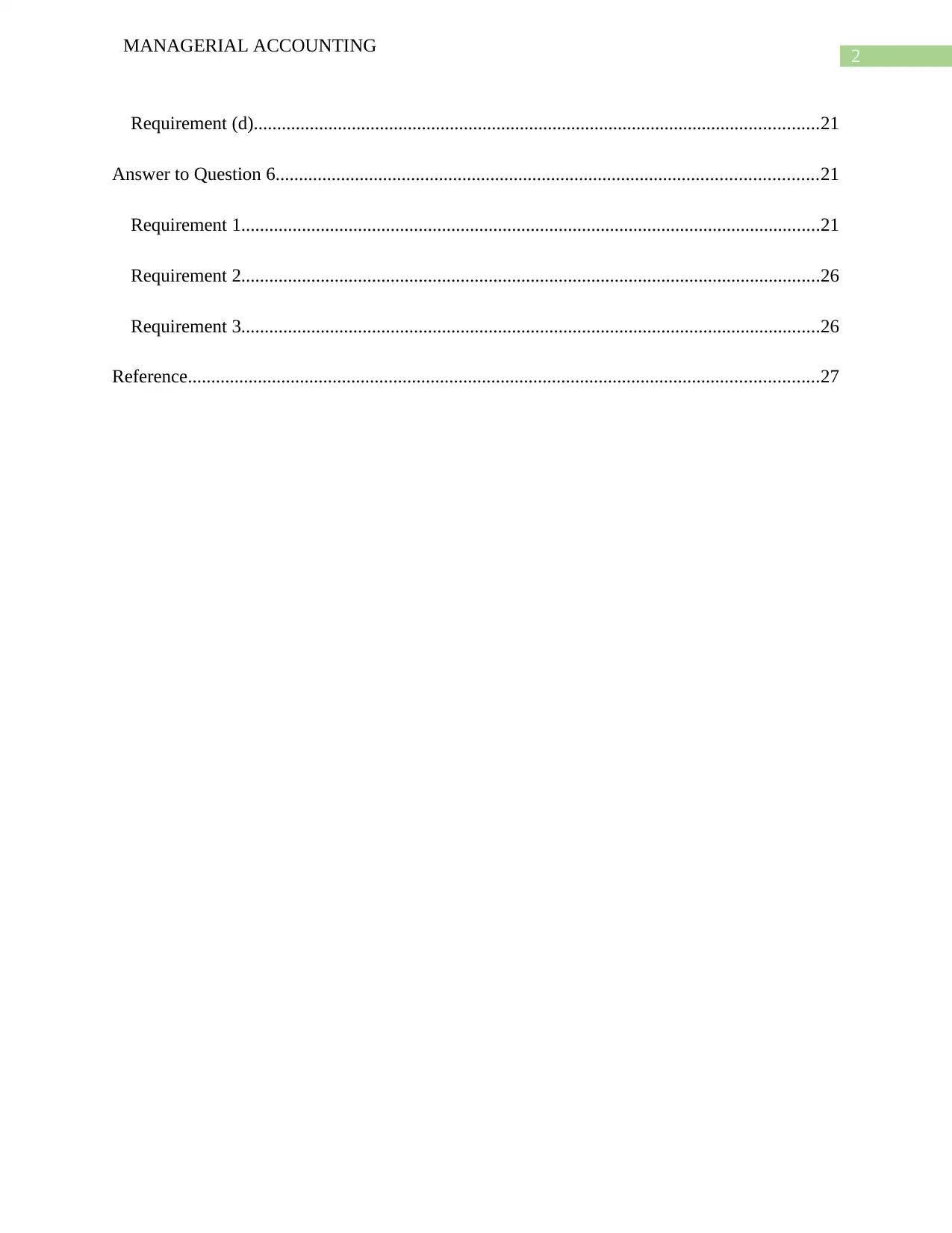
2
MANAGERIAL ACCOUNTING
Requirement (d).........................................................................................................................21
Answer to Question 6....................................................................................................................21
Requirement 1............................................................................................................................21
Requirement 2............................................................................................................................26
Requirement 3............................................................................................................................26
Reference.......................................................................................................................................27
MANAGERIAL ACCOUNTING
Requirement (d).........................................................................................................................21
Answer to Question 6....................................................................................................................21
Requirement 1............................................................................................................................21
Requirement 2............................................................................................................................26
Requirement 3............................................................................................................................26
Reference.......................................................................................................................................27
⊘ This is a preview!⊘
Do you want full access?
Subscribe today to unlock all pages.

Trusted by 1+ million students worldwide
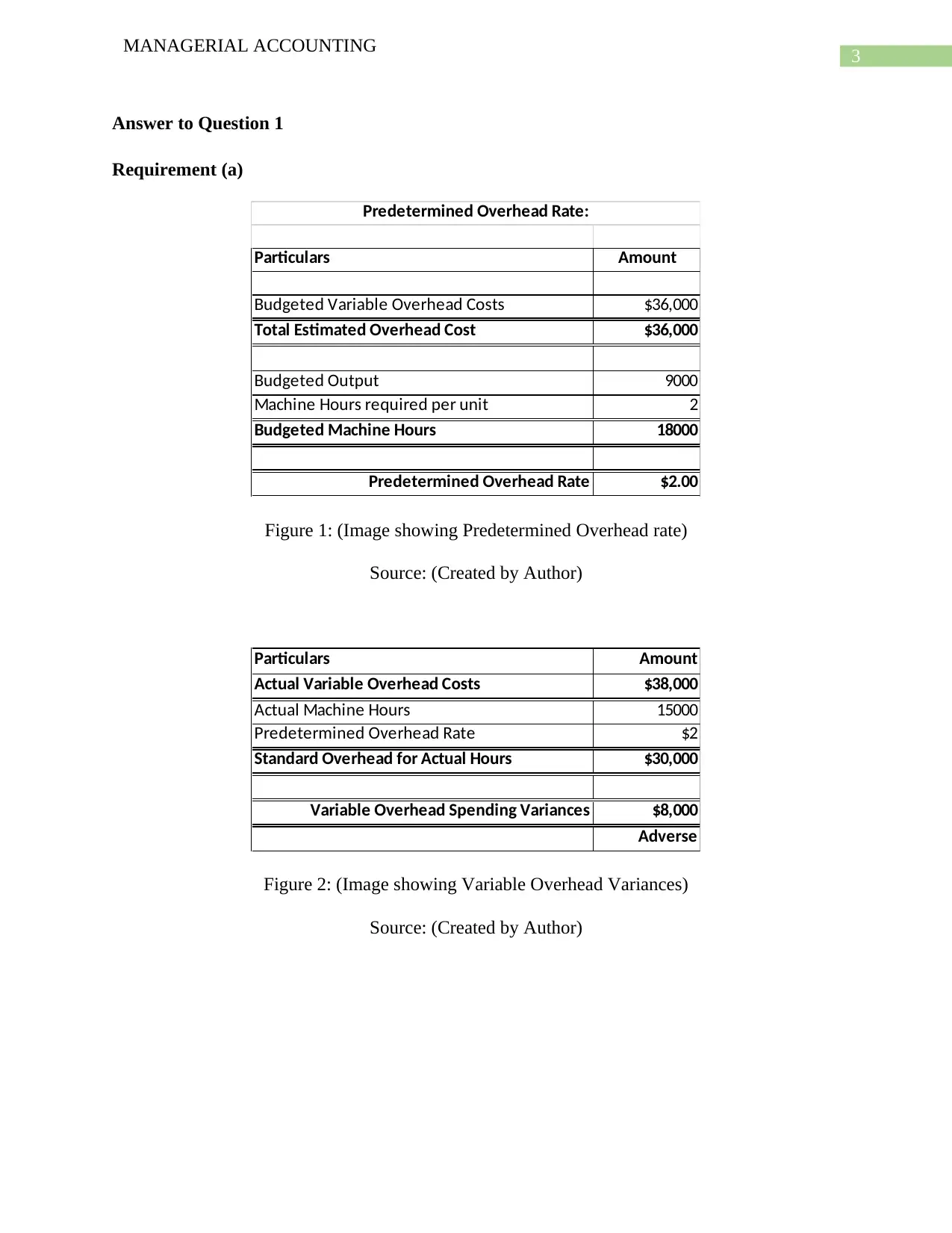
3
MANAGERIAL ACCOUNTING
Answer to Question 1
Requirement (a)
Particulars Amount
Budgeted Variable Overhead Costs $36,000
Total Estimated Overhead Cost $36,000
Budgeted Output 9000
Machine Hours required per unit 2
Budgeted Machine Hours 18000
Predetermined Overhead Rate $2.00
Predetermined Overhead Rate:
Figure 1: (Image showing Predetermined Overhead rate)
Source: (Created by Author)
Particulars Amount
Actual Variable Overhead Costs $38,000
Actual Machine Hours 15000
Predetermined Overhead Rate $2
Standard Overhead for Actual Hours $30,000
Variable Overhead Spending Variances $8,000
Adverse
Figure 2: (Image showing Variable Overhead Variances)
Source: (Created by Author)
MANAGERIAL ACCOUNTING
Answer to Question 1
Requirement (a)
Particulars Amount
Budgeted Variable Overhead Costs $36,000
Total Estimated Overhead Cost $36,000
Budgeted Output 9000
Machine Hours required per unit 2
Budgeted Machine Hours 18000
Predetermined Overhead Rate $2.00
Predetermined Overhead Rate:
Figure 1: (Image showing Predetermined Overhead rate)
Source: (Created by Author)
Particulars Amount
Actual Variable Overhead Costs $38,000
Actual Machine Hours 15000
Predetermined Overhead Rate $2
Standard Overhead for Actual Hours $30,000
Variable Overhead Spending Variances $8,000
Adverse
Figure 2: (Image showing Variable Overhead Variances)
Source: (Created by Author)
Paraphrase This Document
Need a fresh take? Get an instant paraphrase of this document with our AI Paraphraser
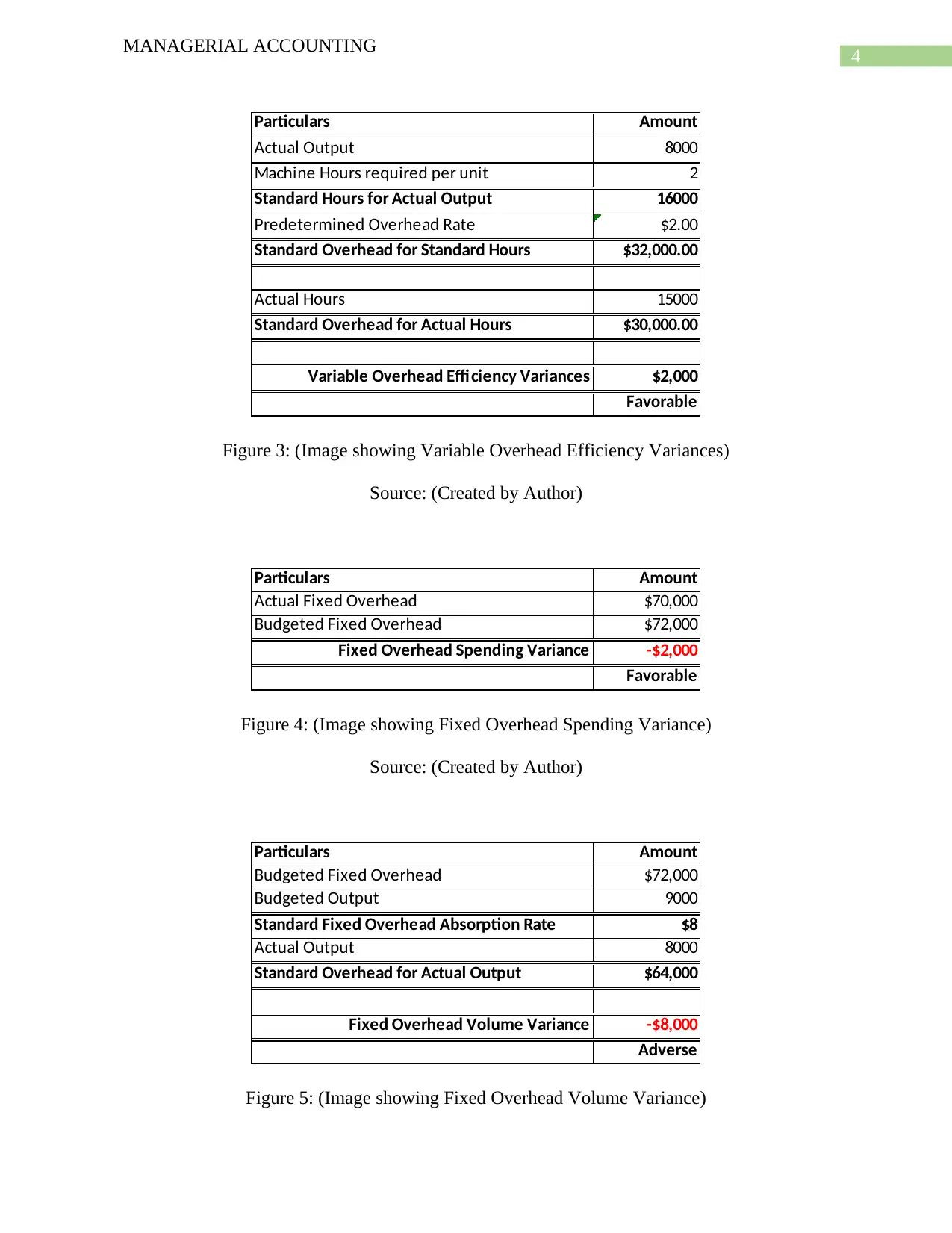
4
MANAGERIAL ACCOUNTING
Particulars Amount
Actual Output 8000
Machine Hours required per unit 2
Standard Hours for Actual Output 16000
Predetermined Overhead Rate $2.00
Standard Overhead for Standard Hours $32,000.00
Actual Hours 15000
Standard Overhead for Actual Hours $30,000.00
Variable Overhead Efficiency Variances $2,000
Favorable
Figure 3: (Image showing Variable Overhead Efficiency Variances)
Source: (Created by Author)
Particulars Amount
Actual Fixed Overhead $70,000
Budgeted Fixed Overhead $72,000
Fixed Overhead Spending Variance -$2,000
Favorable
Figure 4: (Image showing Fixed Overhead Spending Variance)
Source: (Created by Author)
Particulars Amount
Budgeted Fixed Overhead $72,000
Budgeted Output 9000
Standard Fixed Overhead Absorption Rate $8
Actual Output 8000
Standard Overhead for Actual Output $64,000
Fixed Overhead Volume Variance -$8,000
Adverse
Figure 5: (Image showing Fixed Overhead Volume Variance)
MANAGERIAL ACCOUNTING
Particulars Amount
Actual Output 8000
Machine Hours required per unit 2
Standard Hours for Actual Output 16000
Predetermined Overhead Rate $2.00
Standard Overhead for Standard Hours $32,000.00
Actual Hours 15000
Standard Overhead for Actual Hours $30,000.00
Variable Overhead Efficiency Variances $2,000
Favorable
Figure 3: (Image showing Variable Overhead Efficiency Variances)
Source: (Created by Author)
Particulars Amount
Actual Fixed Overhead $70,000
Budgeted Fixed Overhead $72,000
Fixed Overhead Spending Variance -$2,000
Favorable
Figure 4: (Image showing Fixed Overhead Spending Variance)
Source: (Created by Author)
Particulars Amount
Budgeted Fixed Overhead $72,000
Budgeted Output 9000
Standard Fixed Overhead Absorption Rate $8
Actual Output 8000
Standard Overhead for Actual Output $64,000
Fixed Overhead Volume Variance -$8,000
Adverse
Figure 5: (Image showing Fixed Overhead Volume Variance)
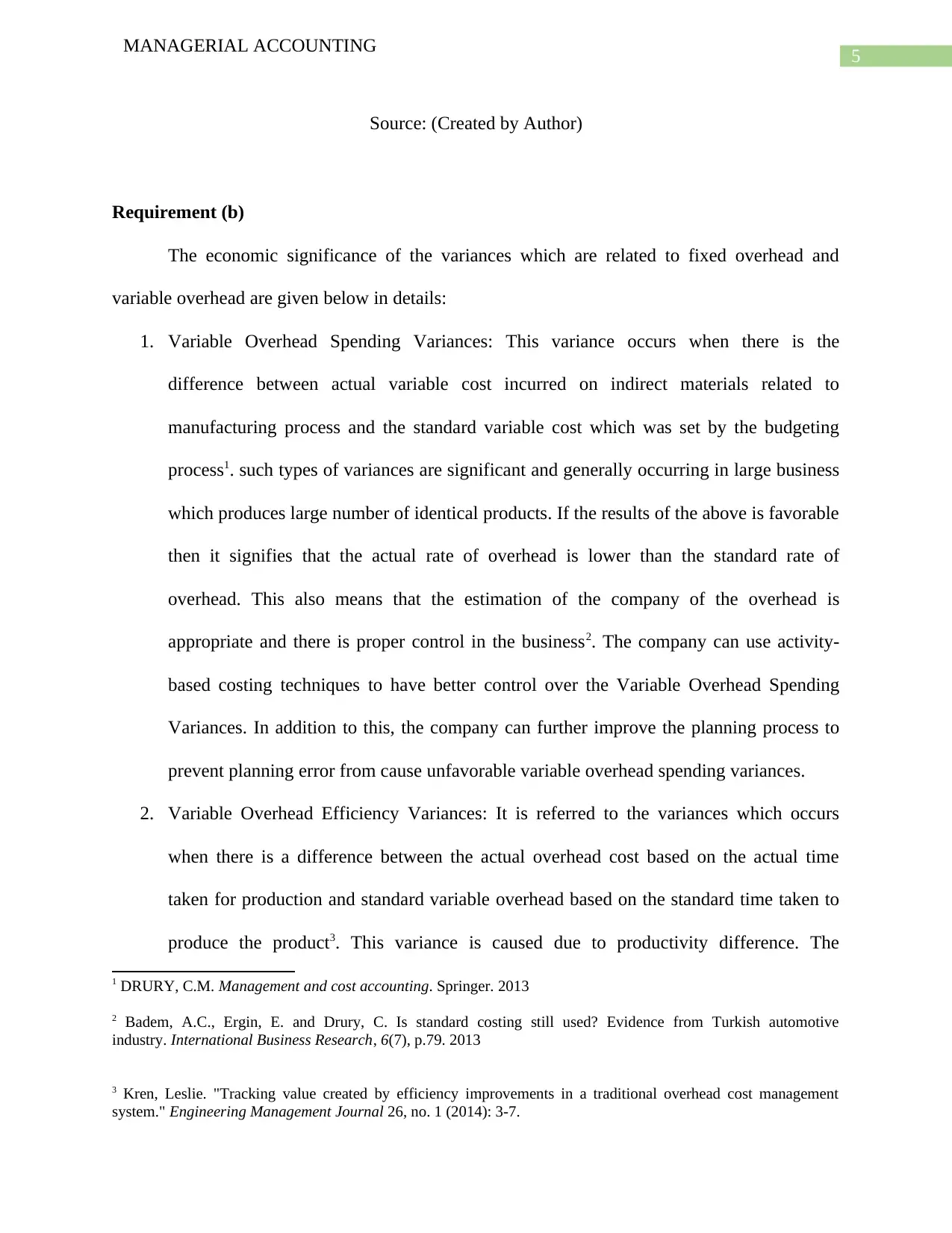
5
MANAGERIAL ACCOUNTING
Source: (Created by Author)
Requirement (b)
The economic significance of the variances which are related to fixed overhead and
variable overhead are given below in details:
1. Variable Overhead Spending Variances: This variance occurs when there is the
difference between actual variable cost incurred on indirect materials related to
manufacturing process and the standard variable cost which was set by the budgeting
process1. such types of variances are significant and generally occurring in large business
which produces large number of identical products. If the results of the above is favorable
then it signifies that the actual rate of overhead is lower than the standard rate of
overhead. This also means that the estimation of the company of the overhead is
appropriate and there is proper control in the business2. The company can use activity-
based costing techniques to have better control over the Variable Overhead Spending
Variances. In addition to this, the company can further improve the planning process to
prevent planning error from cause unfavorable variable overhead spending variances.
2. Variable Overhead Efficiency Variances: It is referred to the variances which occurs
when there is a difference between the actual overhead cost based on the actual time
taken for production and standard variable overhead based on the standard time taken to
produce the product3. This variance is caused due to productivity difference. The
1 DRURY, C.M. Management and cost accounting. Springer. 2013
2 Badem, A.C., Ergin, E. and Drury, C. Is standard costing still used? Evidence from Turkish automotive
industry. International Business Research, 6(7), p.79. 2013
3 Kren, Leslie. "Tracking value created by efficiency improvements in a traditional overhead cost management
system." Engineering Management Journal 26, no. 1 (2014): 3-7.
MANAGERIAL ACCOUNTING
Source: (Created by Author)
Requirement (b)
The economic significance of the variances which are related to fixed overhead and
variable overhead are given below in details:
1. Variable Overhead Spending Variances: This variance occurs when there is the
difference between actual variable cost incurred on indirect materials related to
manufacturing process and the standard variable cost which was set by the budgeting
process1. such types of variances are significant and generally occurring in large business
which produces large number of identical products. If the results of the above is favorable
then it signifies that the actual rate of overhead is lower than the standard rate of
overhead. This also means that the estimation of the company of the overhead is
appropriate and there is proper control in the business2. The company can use activity-
based costing techniques to have better control over the Variable Overhead Spending
Variances. In addition to this, the company can further improve the planning process to
prevent planning error from cause unfavorable variable overhead spending variances.
2. Variable Overhead Efficiency Variances: It is referred to the variances which occurs
when there is a difference between the actual overhead cost based on the actual time
taken for production and standard variable overhead based on the standard time taken to
produce the product3. This variance is caused due to productivity difference. The
1 DRURY, C.M. Management and cost accounting. Springer. 2013
2 Badem, A.C., Ergin, E. and Drury, C. Is standard costing still used? Evidence from Turkish automotive
industry. International Business Research, 6(7), p.79. 2013
3 Kren, Leslie. "Tracking value created by efficiency improvements in a traditional overhead cost management
system." Engineering Management Journal 26, no. 1 (2014): 3-7.
⊘ This is a preview!⊘
Do you want full access?
Subscribe today to unlock all pages.

Trusted by 1+ million students worldwide
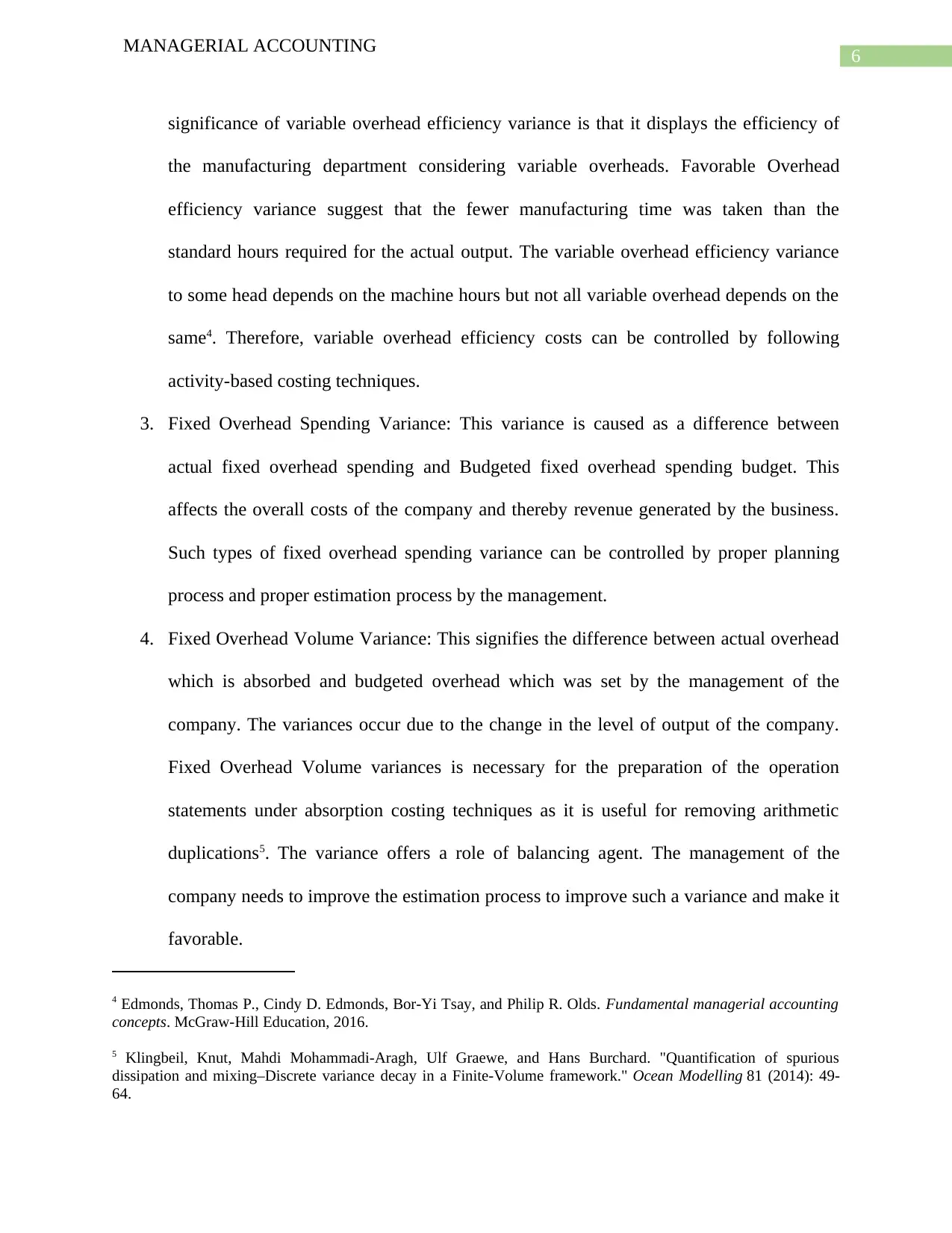
6
MANAGERIAL ACCOUNTING
significance of variable overhead efficiency variance is that it displays the efficiency of
the manufacturing department considering variable overheads. Favorable Overhead
efficiency variance suggest that the fewer manufacturing time was taken than the
standard hours required for the actual output. The variable overhead efficiency variance
to some head depends on the machine hours but not all variable overhead depends on the
same4. Therefore, variable overhead efficiency costs can be controlled by following
activity-based costing techniques.
3. Fixed Overhead Spending Variance: This variance is caused as a difference between
actual fixed overhead spending and Budgeted fixed overhead spending budget. This
affects the overall costs of the company and thereby revenue generated by the business.
Such types of fixed overhead spending variance can be controlled by proper planning
process and proper estimation process by the management.
4. Fixed Overhead Volume Variance: This signifies the difference between actual overhead
which is absorbed and budgeted overhead which was set by the management of the
company. The variances occur due to the change in the level of output of the company.
Fixed Overhead Volume variances is necessary for the preparation of the operation
statements under absorption costing techniques as it is useful for removing arithmetic
duplications5. The variance offers a role of balancing agent. The management of the
company needs to improve the estimation process to improve such a variance and make it
favorable.
4 Edmonds, Thomas P., Cindy D. Edmonds, Bor-Yi Tsay, and Philip R. Olds. Fundamental managerial accounting
concepts. McGraw-Hill Education, 2016.
5 Klingbeil, Knut, Mahdi Mohammadi-Aragh, Ulf Graewe, and Hans Burchard. "Quantification of spurious
dissipation and mixing–Discrete variance decay in a Finite-Volume framework." Ocean Modelling 81 (2014): 49-
64.
MANAGERIAL ACCOUNTING
significance of variable overhead efficiency variance is that it displays the efficiency of
the manufacturing department considering variable overheads. Favorable Overhead
efficiency variance suggest that the fewer manufacturing time was taken than the
standard hours required for the actual output. The variable overhead efficiency variance
to some head depends on the machine hours but not all variable overhead depends on the
same4. Therefore, variable overhead efficiency costs can be controlled by following
activity-based costing techniques.
3. Fixed Overhead Spending Variance: This variance is caused as a difference between
actual fixed overhead spending and Budgeted fixed overhead spending budget. This
affects the overall costs of the company and thereby revenue generated by the business.
Such types of fixed overhead spending variance can be controlled by proper planning
process and proper estimation process by the management.
4. Fixed Overhead Volume Variance: This signifies the difference between actual overhead
which is absorbed and budgeted overhead which was set by the management of the
company. The variances occur due to the change in the level of output of the company.
Fixed Overhead Volume variances is necessary for the preparation of the operation
statements under absorption costing techniques as it is useful for removing arithmetic
duplications5. The variance offers a role of balancing agent. The management of the
company needs to improve the estimation process to improve such a variance and make it
favorable.
4 Edmonds, Thomas P., Cindy D. Edmonds, Bor-Yi Tsay, and Philip R. Olds. Fundamental managerial accounting
concepts. McGraw-Hill Education, 2016.
5 Klingbeil, Knut, Mahdi Mohammadi-Aragh, Ulf Graewe, and Hans Burchard. "Quantification of spurious
dissipation and mixing–Discrete variance decay in a Finite-Volume framework." Ocean Modelling 81 (2014): 49-
64.
Paraphrase This Document
Need a fresh take? Get an instant paraphrase of this document with our AI Paraphraser
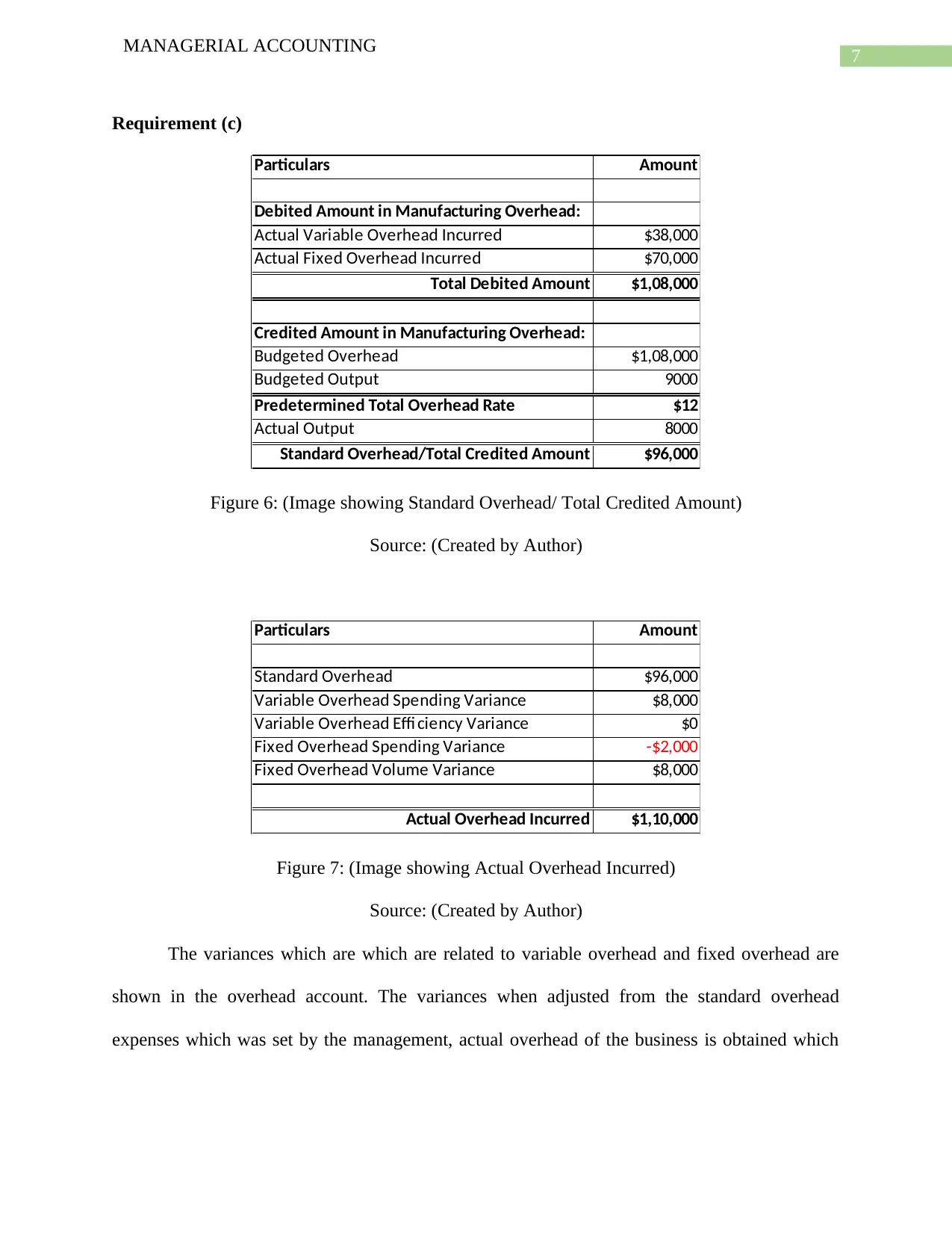
7
MANAGERIAL ACCOUNTING
Requirement (c)
Particulars Amount
Debited Amount in Manufacturing Overhead:
Actual Variable Overhead Incurred $38,000
Actual Fixed Overhead Incurred $70,000
Total Debited Amount $1,08,000
Credited Amount in Manufacturing Overhead:
Budgeted Overhead $1,08,000
Budgeted Output 9000
Predetermined Total Overhead Rate $12
Actual Output 8000
Standard Overhead/Total Credited Amount $96,000
Figure 6: (Image showing Standard Overhead/ Total Credited Amount)
Source: (Created by Author)
Particulars Amount
Standard Overhead $96,000
Variable Overhead Spending Variance $8,000
Variable Overhead Effi ciency Variance $0
Fixed Overhead Spending Variance -$2,000
Fixed Overhead Volume Variance $8,000
Actual Overhead Incurred $1,10,000
Figure 7: (Image showing Actual Overhead Incurred)
Source: (Created by Author)
The variances which are which are related to variable overhead and fixed overhead are
shown in the overhead account. The variances when adjusted from the standard overhead
expenses which was set by the management, actual overhead of the business is obtained which
MANAGERIAL ACCOUNTING
Requirement (c)
Particulars Amount
Debited Amount in Manufacturing Overhead:
Actual Variable Overhead Incurred $38,000
Actual Fixed Overhead Incurred $70,000
Total Debited Amount $1,08,000
Credited Amount in Manufacturing Overhead:
Budgeted Overhead $1,08,000
Budgeted Output 9000
Predetermined Total Overhead Rate $12
Actual Output 8000
Standard Overhead/Total Credited Amount $96,000
Figure 6: (Image showing Standard Overhead/ Total Credited Amount)
Source: (Created by Author)
Particulars Amount
Standard Overhead $96,000
Variable Overhead Spending Variance $8,000
Variable Overhead Effi ciency Variance $0
Fixed Overhead Spending Variance -$2,000
Fixed Overhead Volume Variance $8,000
Actual Overhead Incurred $1,10,000
Figure 7: (Image showing Actual Overhead Incurred)
Source: (Created by Author)
The variances which are which are related to variable overhead and fixed overhead are
shown in the overhead account. The variances when adjusted from the standard overhead
expenses which was set by the management, actual overhead of the business is obtained which
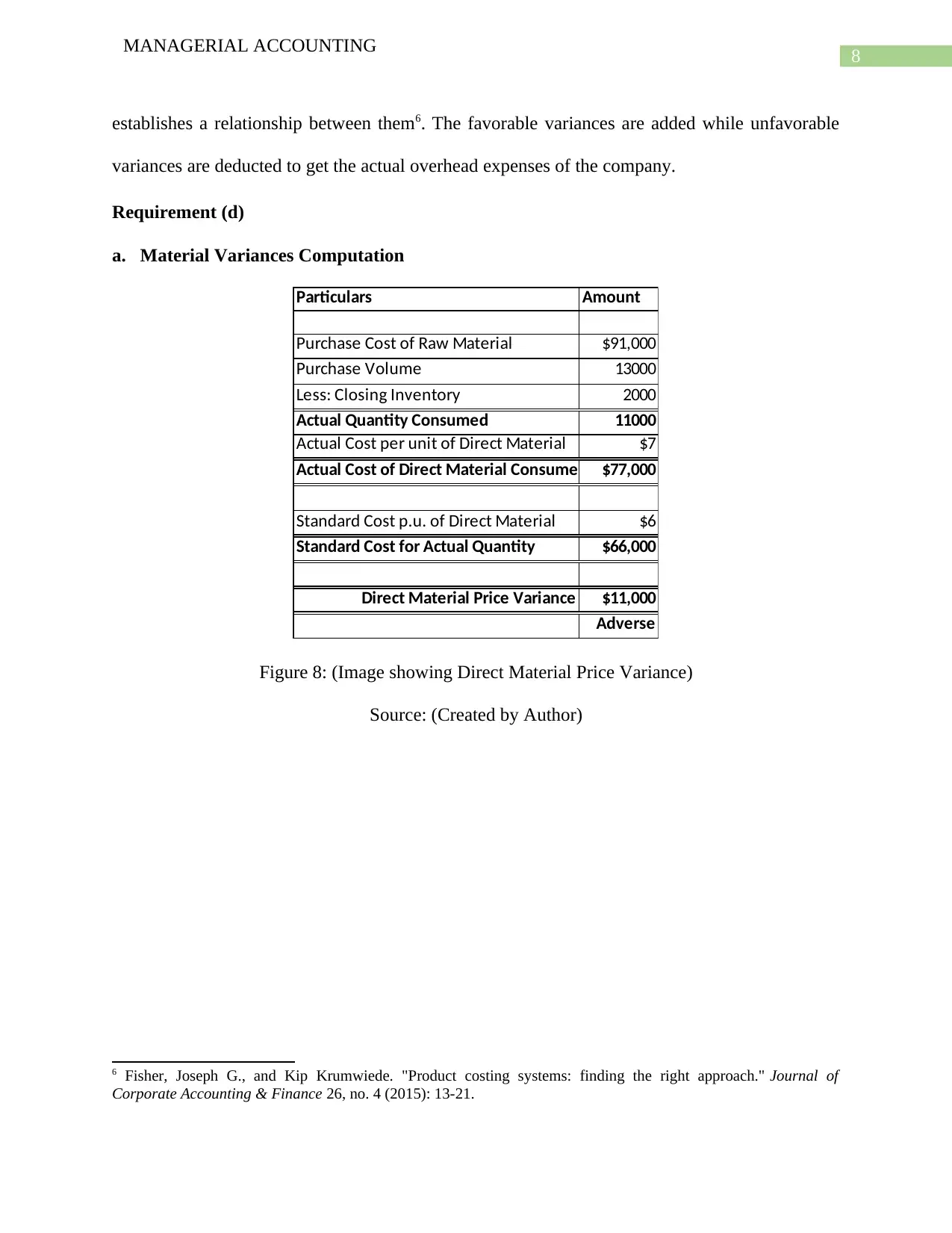
8
MANAGERIAL ACCOUNTING
establishes a relationship between them6. The favorable variances are added while unfavorable
variances are deducted to get the actual overhead expenses of the company.
Requirement (d)
a. Material Variances Computation
Particulars Amount
Purchase Cost of Raw Material $91,000
Purchase Volume 13000
Less: Closing Inventory 2000
Actual Quantity Consumed 11000
Actual Cost per unit of Direct Material $7
Actual Cost of Direct Material Consumed $77,000
Standard Cost p.u. of Direct Material $6
Standard Cost for Actual Quantity $66,000
Direct Material Price Variance $11,000
Adverse
Figure 8: (Image showing Direct Material Price Variance)
Source: (Created by Author)
6 Fisher, Joseph G., and Kip Krumwiede. "Product costing systems: finding the right approach." Journal of
Corporate Accounting & Finance 26, no. 4 (2015): 13-21.
MANAGERIAL ACCOUNTING
establishes a relationship between them6. The favorable variances are added while unfavorable
variances are deducted to get the actual overhead expenses of the company.
Requirement (d)
a. Material Variances Computation
Particulars Amount
Purchase Cost of Raw Material $91,000
Purchase Volume 13000
Less: Closing Inventory 2000
Actual Quantity Consumed 11000
Actual Cost per unit of Direct Material $7
Actual Cost of Direct Material Consumed $77,000
Standard Cost p.u. of Direct Material $6
Standard Cost for Actual Quantity $66,000
Direct Material Price Variance $11,000
Adverse
Figure 8: (Image showing Direct Material Price Variance)
Source: (Created by Author)
6 Fisher, Joseph G., and Kip Krumwiede. "Product costing systems: finding the right approach." Journal of
Corporate Accounting & Finance 26, no. 4 (2015): 13-21.
⊘ This is a preview!⊘
Do you want full access?
Subscribe today to unlock all pages.

Trusted by 1+ million students worldwide
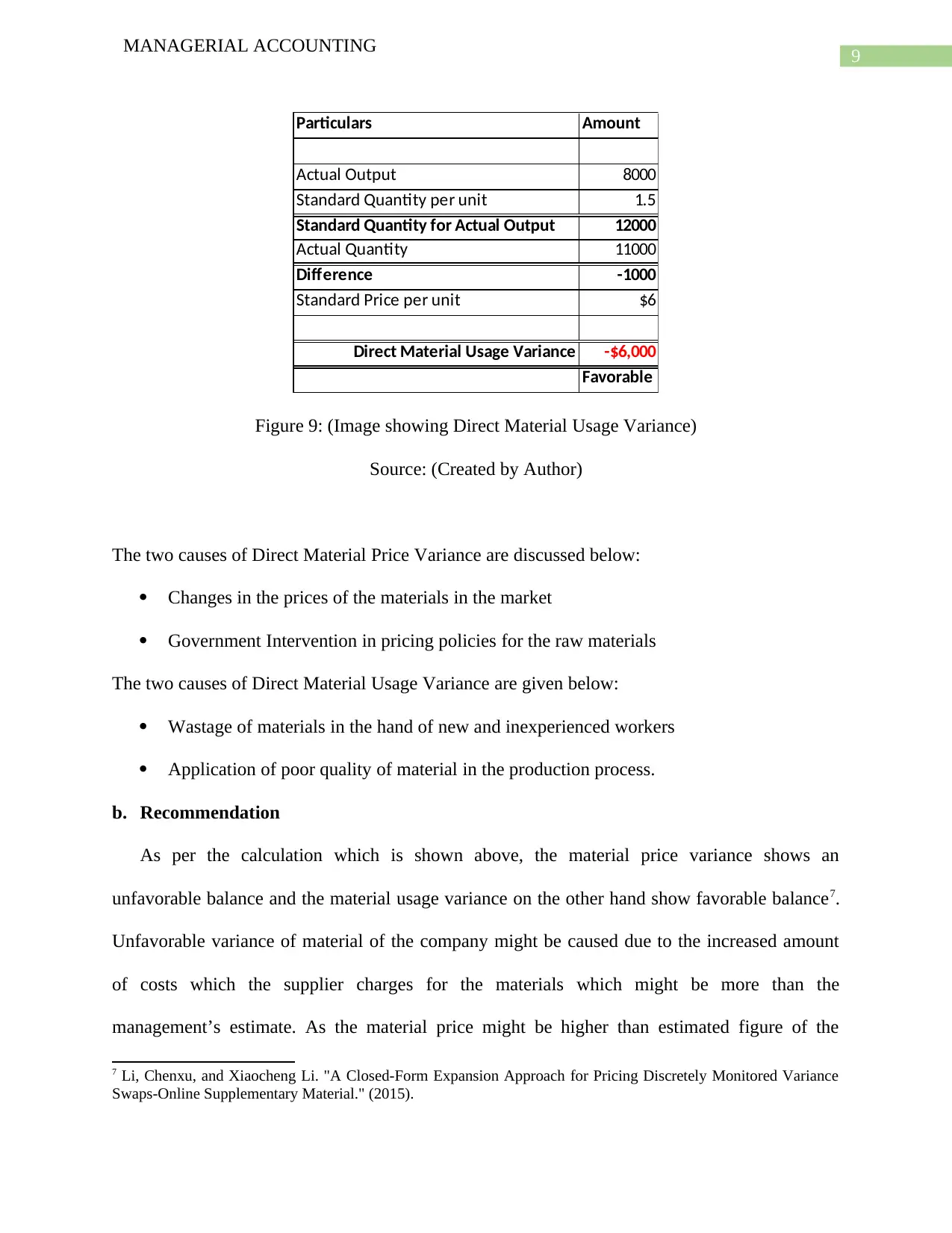
9
MANAGERIAL ACCOUNTING
Particulars Amount
Actual Output 8000
Standard Quantity per unit 1.5
Standard Quantity for Actual Output 12000
Actual Quantity 11000
Difference -1000
Standard Price per unit $6
Direct Material Usage Variance -$6,000
Favorable
Figure 9: (Image showing Direct Material Usage Variance)
Source: (Created by Author)
The two causes of Direct Material Price Variance are discussed below:
Changes in the prices of the materials in the market
Government Intervention in pricing policies for the raw materials
The two causes of Direct Material Usage Variance are given below:
Wastage of materials in the hand of new and inexperienced workers
Application of poor quality of material in the production process.
b. Recommendation
As per the calculation which is shown above, the material price variance shows an
unfavorable balance and the material usage variance on the other hand show favorable balance7.
Unfavorable variance of material of the company might be caused due to the increased amount
of costs which the supplier charges for the materials which might be more than the
management’s estimate. As the material price might be higher than estimated figure of the
7 Li, Chenxu, and Xiaocheng Li. "A Closed-Form Expansion Approach for Pricing Discretely Monitored Variance
Swaps-Online Supplementary Material." (2015).
MANAGERIAL ACCOUNTING
Particulars Amount
Actual Output 8000
Standard Quantity per unit 1.5
Standard Quantity for Actual Output 12000
Actual Quantity 11000
Difference -1000
Standard Price per unit $6
Direct Material Usage Variance -$6,000
Favorable
Figure 9: (Image showing Direct Material Usage Variance)
Source: (Created by Author)
The two causes of Direct Material Price Variance are discussed below:
Changes in the prices of the materials in the market
Government Intervention in pricing policies for the raw materials
The two causes of Direct Material Usage Variance are given below:
Wastage of materials in the hand of new and inexperienced workers
Application of poor quality of material in the production process.
b. Recommendation
As per the calculation which is shown above, the material price variance shows an
unfavorable balance and the material usage variance on the other hand show favorable balance7.
Unfavorable variance of material of the company might be caused due to the increased amount
of costs which the supplier charges for the materials which might be more than the
management’s estimate. As the material price might be higher than estimated figure of the
7 Li, Chenxu, and Xiaocheng Li. "A Closed-Form Expansion Approach for Pricing Discretely Monitored Variance
Swaps-Online Supplementary Material." (2015).
Paraphrase This Document
Need a fresh take? Get an instant paraphrase of this document with our AI Paraphraser
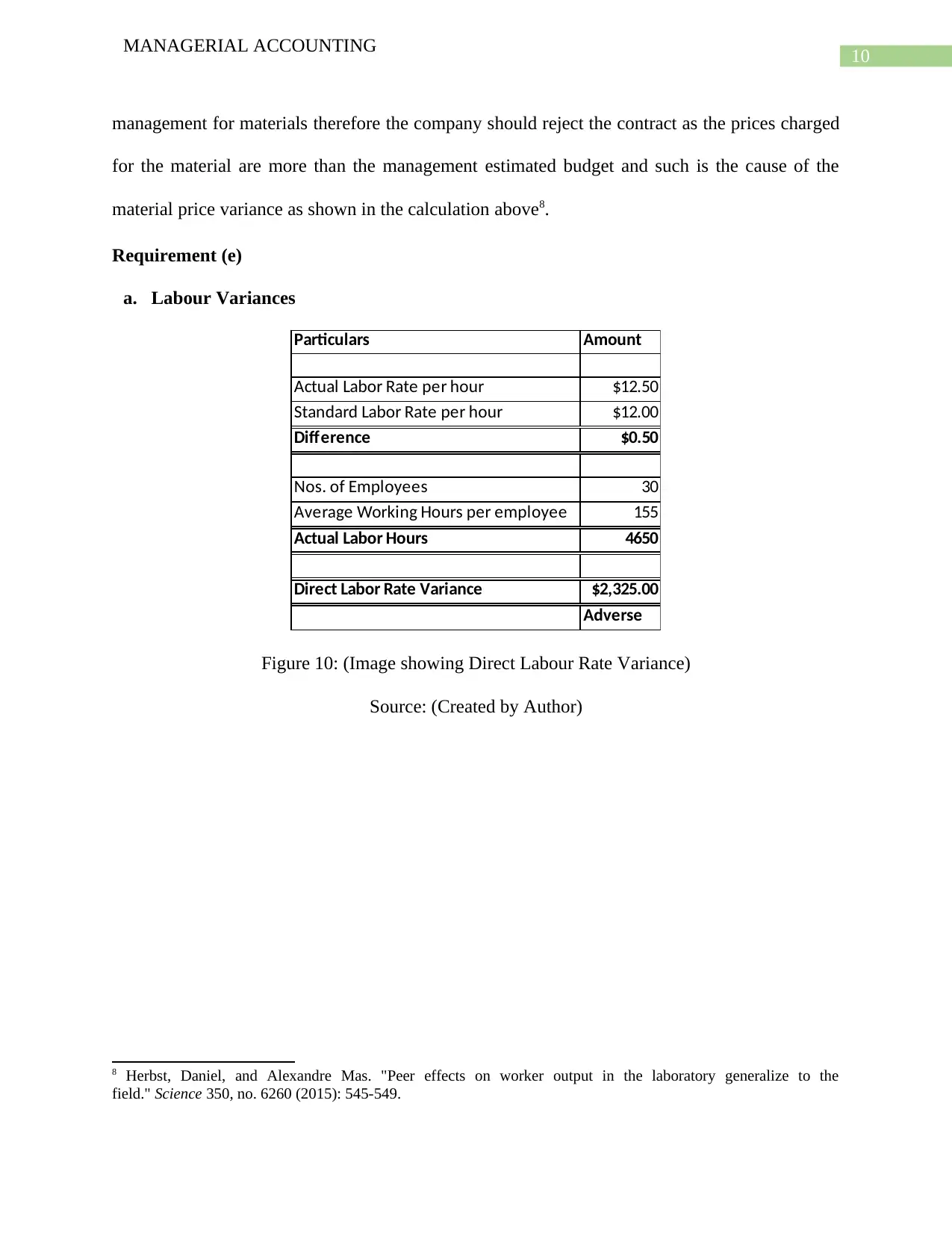
10
MANAGERIAL ACCOUNTING
management for materials therefore the company should reject the contract as the prices charged
for the material are more than the management estimated budget and such is the cause of the
material price variance as shown in the calculation above8.
Requirement (e)
a. Labour Variances
Particulars Amount
Actual Labor Rate per hour $12.50
Standard Labor Rate per hour $12.00
Difference $0.50
Nos. of Employees 30
Average Working Hours per employee 155
Actual Labor Hours 4650
Direct Labor Rate Variance $2,325.00
Adverse
Figure 10: (Image showing Direct Labour Rate Variance)
Source: (Created by Author)
8 Herbst, Daniel, and Alexandre Mas. "Peer effects on worker output in the laboratory generalize to the
field." Science 350, no. 6260 (2015): 545-549.
MANAGERIAL ACCOUNTING
management for materials therefore the company should reject the contract as the prices charged
for the material are more than the management estimated budget and such is the cause of the
material price variance as shown in the calculation above8.
Requirement (e)
a. Labour Variances
Particulars Amount
Actual Labor Rate per hour $12.50
Standard Labor Rate per hour $12.00
Difference $0.50
Nos. of Employees 30
Average Working Hours per employee 155
Actual Labor Hours 4650
Direct Labor Rate Variance $2,325.00
Adverse
Figure 10: (Image showing Direct Labour Rate Variance)
Source: (Created by Author)
8 Herbst, Daniel, and Alexandre Mas. "Peer effects on worker output in the laboratory generalize to the
field." Science 350, no. 6260 (2015): 545-549.
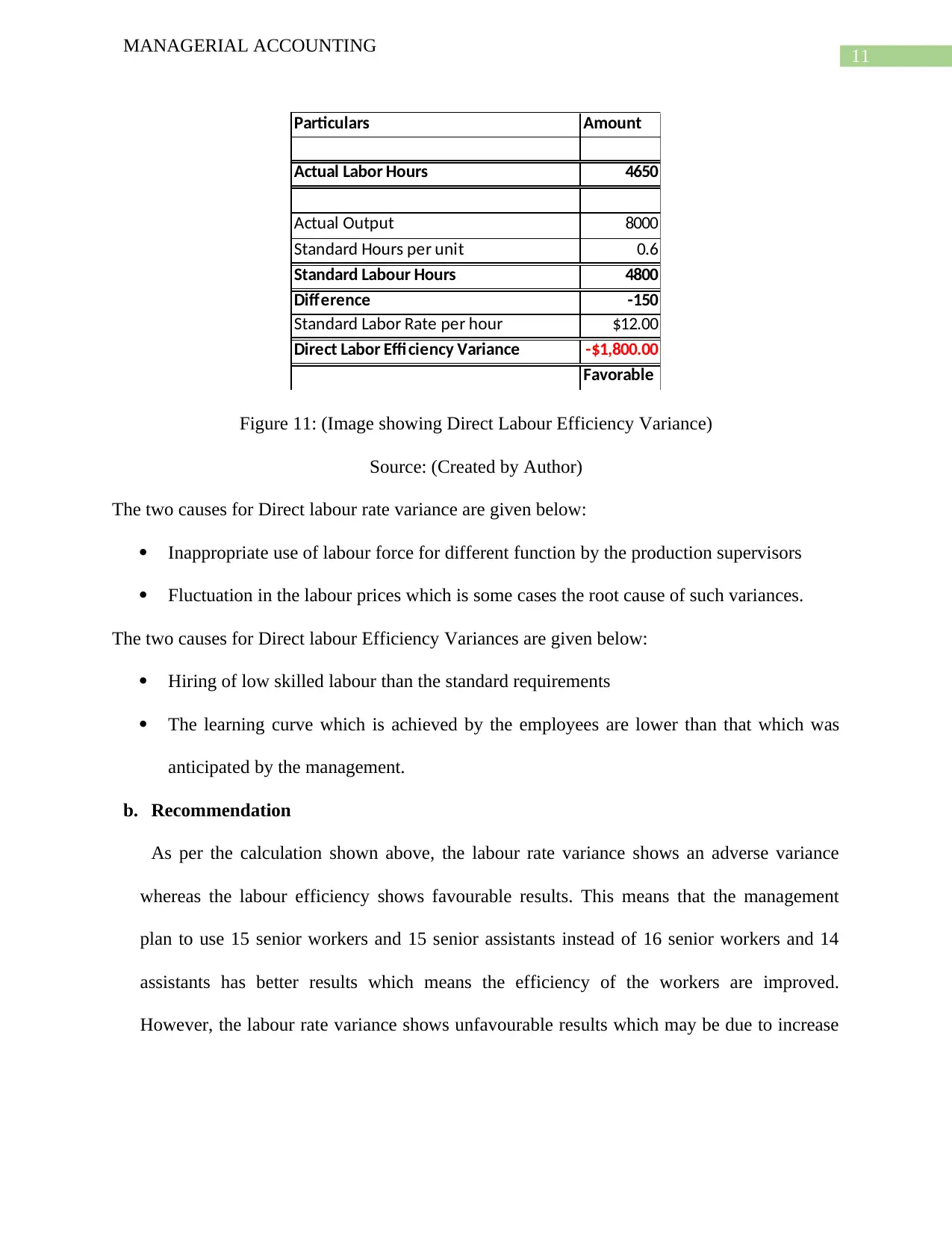
11
MANAGERIAL ACCOUNTING
Particulars Amount
Actual Labor Hours 4650
Actual Output 8000
Standard Hours per unit 0.6
Standard Labour Hours 4800
Difference -150
Standard Labor Rate per hour $12.00
Direct Labor Efficiency Variance -$1,800.00
Favorable
Figure 11: (Image showing Direct Labour Efficiency Variance)
Source: (Created by Author)
The two causes for Direct labour rate variance are given below:
Inappropriate use of labour force for different function by the production supervisors
Fluctuation in the labour prices which is some cases the root cause of such variances.
The two causes for Direct labour Efficiency Variances are given below:
Hiring of low skilled labour than the standard requirements
The learning curve which is achieved by the employees are lower than that which was
anticipated by the management.
b. Recommendation
As per the calculation shown above, the labour rate variance shows an adverse variance
whereas the labour efficiency shows favourable results. This means that the management
plan to use 15 senior workers and 15 senior assistants instead of 16 senior workers and 14
assistants has better results which means the efficiency of the workers are improved.
However, the labour rate variance shows unfavourable results which may be due to increase
MANAGERIAL ACCOUNTING
Particulars Amount
Actual Labor Hours 4650
Actual Output 8000
Standard Hours per unit 0.6
Standard Labour Hours 4800
Difference -150
Standard Labor Rate per hour $12.00
Direct Labor Efficiency Variance -$1,800.00
Favorable
Figure 11: (Image showing Direct Labour Efficiency Variance)
Source: (Created by Author)
The two causes for Direct labour rate variance are given below:
Inappropriate use of labour force for different function by the production supervisors
Fluctuation in the labour prices which is some cases the root cause of such variances.
The two causes for Direct labour Efficiency Variances are given below:
Hiring of low skilled labour than the standard requirements
The learning curve which is achieved by the employees are lower than that which was
anticipated by the management.
b. Recommendation
As per the calculation shown above, the labour rate variance shows an adverse variance
whereas the labour efficiency shows favourable results. This means that the management
plan to use 15 senior workers and 15 senior assistants instead of 16 senior workers and 14
assistants has better results which means the efficiency of the workers are improved.
However, the labour rate variance shows unfavourable results which may be due to increase
⊘ This is a preview!⊘
Do you want full access?
Subscribe today to unlock all pages.

Trusted by 1+ million students worldwide
1 out of 30
Related Documents
Your All-in-One AI-Powered Toolkit for Academic Success.
+13062052269
info@desklib.com
Available 24*7 on WhatsApp / Email
![[object Object]](/_next/static/media/star-bottom.7253800d.svg)
Unlock your academic potential
Copyright © 2020–2025 A2Z Services. All Rights Reserved. Developed and managed by ZUCOL.





